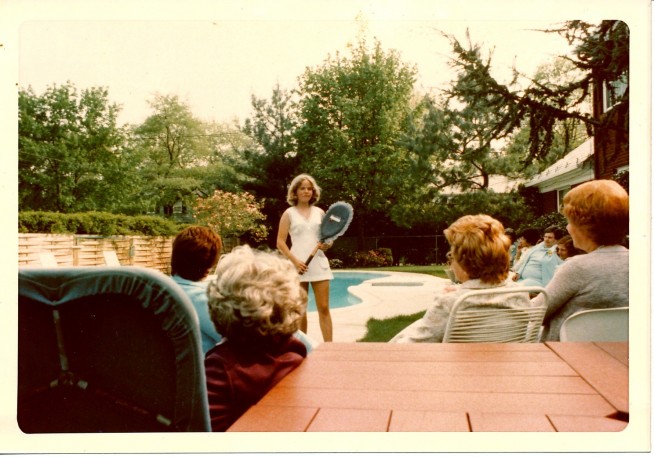This morning, I came upon this quote from Bill Watterson, creator of the Calvin and Hobbes comic strip:
“You will do well to cultivate the resources in yourself that bring you happiness outside of success or failure. The truth is, most of us discover where we are headed when we arrive. At that time, we turn around and say, yes, this is obviously where I was going all along.”
My husband recently spent a rainy day down in our very messy basement starting to sort through ten years and several lifetimes’ worth of things that were once important (copies of old contracts and tax returns), indispensable (high chairs, strollers), or of sentimental value (kindergarten art work, stacks of holiday cards). He also came across a stash of memorabilia and photographs from my childhood, which included a photo of me as an awkward, incredibly uncomfortable fourteen year old, modeling tennis clothes for a group of suburban ladies in the backyard of my childhood home.
As soon as I saw it, a particular summer afternoon came flooding back to me.
The heat of the day. The “fashion show” that my mother put on for the neighborhood ladies to introduce them to her new line of tennis towels and tennis jewelry, modeled by her daughter Dani. The way I felt, circling the swimming pool in a little white tennis dress, wearing a necklace with a gold tennis ball affixed with a sapphire eye (the motto being “keep your eye on the ball”). The strange mixture of self-consciousness, embarrassment, and the awareness, lurking somewhere, that something was very wrong with this picture. That I was being put on display—I was well used to being put on display—and that the whole episode was mortifying. Did I also feel pride? Was I enjoying, on some level, being paraded in front of the ladies? It’s possible. I don’t remember. I am only able to touch a vague feeling of unease and numbness. I didn’t know the first thing about myself.
I am writing this from the chaise lounge in my home office. My son and his friend are outside, shooting hoops. My dog is crashed on the rug by my feet. My husband is downstairs in the basement, probably still sorting. It’s a warm New England weekend. I am in mid-life. A wife. Mother. Writer. Teacher. Friend.
I have lately been very aware that this journey of mine could not have been mapped out.
That the fourteen-year-old girl smiling bashfully in that photograph couldn’t, in her wildest dreams, have imagined the life that would unfold for her. She didn’t even know to dream it. Nor could she have imagined it at twenty. Or even at thirty.
How we spend our days, Annie Dillard once wrote, is, of course, how we spend our lives. Our lives are a chain of these days. We grow, or we stagnate. We form good habits, disciplines, or destructive ones. Or sometimes both. We learn from our mistakes, or we keep repeating them until we’re in enough pain to make changes. I can supply a narrative to my life, shape and carve the story so that it seems to make sense. But there is no straight arrow pointing from that girl with the tennis racket to the woman on the chaise lounge. No game of connect-the-dots. There is only the blessed, hard work of living and allowing life to shape us, as water shapes rock.
If I could reach back through time and whisper something to that girl, it would simply be this: be patient. Be kind to yourself. And wake up.
Dani Shapiro’s most recent books include the bestselling memoirs Devotion and Slow Motion and the novels Black & White and Family History. She teaches writing workshops nationally and internationally. Her stories and essays have appeared in The New Yorker, O The Oprah Magazine, Elle, Vogue, The New York Times Book Review, and many other publications, and have been broadcast on NPR’s “This American Life.” She lives with her family in Connecticut. You can also follow Dani on Twitter and Facebook.
PURCHASE DANI’S UPCOMING BOOK HERE:












